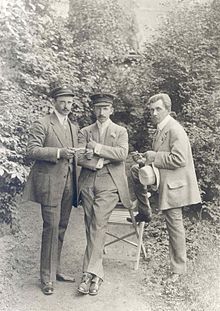Heinrich Schönfeldt
Heinrich Schönfeldt (born April 4, 1884 at Ginselberg Castle near Scheibbs , Lower Austria ; † November 27, 1963 there ; until 1919 Heinrich Maria Hilmar, Count von Schönfeldt ) was the most successful Austrian racing driver of the early 20th century, automotive engineer, aircraft pilot in the I World War I , head of the imperial automobile industry under Emperor Charles I and the driver of the world's first armored vehicle.
Life
Schönfeldt was born in Scheibbs Castle Ginselberg , which was his residence until his death. His parents were the landowner and officer Heinrich, Count von Schönfeldt (1860–1915) and his wife Olga, b. Grimmer von Adelsbach (1862–1949). His paternal grandmother was a Festetics de Tolna , his great-grandmother a Pálffy . The family comes from Vienna.
He attended high school in Villach and the Cavalry - Cadet School in Moravian-Weisskirchen / Hranice (Czech Republic) , where he was retired 1,903th After studying in Mittweida and his first job at Austro-Daimler , Heinrich Schönfeldt was hired by Fiat in 1913 to head the repair and testing department there. In 1914 the Daimler company brought him back.
In 1916 he was entrusted with the management of the imperial automobile industry, at the imperial court Schönfeldt, who had previously served as an aviator at the front in Carinthia and as a driver in Albania, took over "the entire technical management and supervision of the court automobile administration." In the same year he married Margarethe Lenz in Vienna. The marriage was divorced in 1935 and in 1938 he remarried, this time Albine Resch. In 1918 he took over the representation of a patent exploitation company, in the same year his brother Alexander Ludwig died of the Spanish flu . Contact with the Steyr works began in 1921 , for which Schönfeldt initially drove alpine, mountain and flat races, and in 1934 at the Nürburgring . In 1925, the Steyr works entrusted him with the inspection of their branches. From 1939 to 1946, Schönfeldt worked as a claims officer for an insurance company .
Tank driver 1906
Schönfeldt was interested in technology from an early age, when he joined the Dragoons as a cadet in 1903 and came on a Puch motorcycle. In 1905 he had his first car (16 hp), in 1905 a Graef & Stift Spitzwagen, and in 1906 a 40 hp Mercedes. He was one of the first hundred Austrians to hold a driver's license and was selected in 1906 to drive the world's first armored vehicle , which had been designed by Paul Daimler in Wiener Neustadt from 1903 . This was a kind of armored car with rotating dome with two machine guns , four-wheel drive vollgepanzert, with solid rubber tires and off-road ratio . After tests in Wiener Neustadt, the tank of Kaiser Franz Joseph I was demonstrated in Teschen . The device was very loud, a horse was frightened and threw off a general. The aging emperor waved this off and the project was discontinued.
constructor
Nevertheless, Schönfeldt continued to pursue an automobile career. He said goodbye to the army , studied mechanical engineering at the Polytechnic in Mittweida and then joined the Daimler works in Wiener Neustadt as a production engineer , where he worked with the chief designer, his friend Ferdinand Porsche , and Eduard Fischer and formed the so-called "Iron Team" educated. At that time he was head of the driving department at Daimler and was responsible for testing the mortar truck. In 1914 he finally had to enter the First World War . After 1918 he returned to the private sector and continued his work as a designer at the Steyr works and BMW .
Racing driver
From around 1908, Schönfeldt's first racing successes began, which continued in 1909 and 1910 with the Prince Heinrich rides . This was followed by the international Alpine rides of the Austrian Automobile Club from 1910 to 1914, during which the "Iron Team" always worked together and Schönfeldt always finished these first five Alpine rides as the winner. After the First World War, Schönfeldt took up racing again privately. In 1921 and 1922 he again won the ÖAC Alpine Tour and the Masaryk Prize in the Czech Tour in the same year. In 1923 he was involved in the team victory in the Alföld-Alpenfahrt , in 1922 and 1923 he won the Semmering race and the giant race, and in 1924 the Balaton-Fahrt . He achieved one of his greatest successes at the Alpine Tour in 1925, when he not only won the race, but also the team prize and five special prizes. After many more successes, he finally retired from motorsport.
literature
- Michaela Hermann, Gerhard Trumler: Scheibbs in Ötscherland. Scheibbs 2006.
- Rolf M. Urrisk: 100 Years of Panzer Weapons in the Austrian Army / Bd. 11.
- Martin Pfundner: Austro Daimler and Steyr. Rivals until the merger. Ferdinand Porsche's early years. Böhlau, Vienna 2007, ISBN 978-3-205-77639-0 , p. 102 ( restricted view in Google Book Search ).
Web links
- Entry on Schönfeldt, Heinrich in the Austria-Forum , author / editing: Helga Maria Wolf (biography)
- Heinrich Maria Hilmar, Count of Schönfeldt. Entry in geneall.net
- World's first tank 1906
Individual evidence
- ↑ See Nobility Repeal Act of April 3, 1919.
- ↑ Article: "Austrian Tank History: Overcoming Trenches" in "derStandard.at" of November 30, 2016
| personal data | |
|---|---|
| SURNAME | Schönfeldt, Heinrich |
| ALTERNATIVE NAMES | Schönfeldt, Heinrich Maria Hilmar Graf von (birth name) |
| BRIEF DESCRIPTION | Austrian automobile racing driver |
| DATE OF BIRTH | April 4, 1884 |
| PLACE OF BIRTH | Scheibbs |
| DATE OF DEATH | November 27, 1963 |
| Place of death | Scheibbs |




